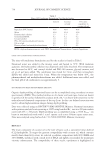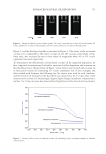640 JOURNAL OF COSMETIC SCIENCE numbers and S. aureus biofilms, which are very hard to break down with treatment. So, Malassezia may be secreting an enzyme making life more difficult for S aureus (24). This sounds like a mutualist benefit, with Malassezia, in some cases, being beneficial for skin. MOVING FORWARD Now what? Malassezia represent many different species, some awaiting cultivation and others even awaiting identification. They do different things: they can do nothing, they can be good, or they can be bad. How do we move forward to understand and to treat dandruff and other common skin diseases impacted by Malassezia? How will we replace the broad- spectrum antifungal materials in shampoos? How are we going to design treatments that work? Heinrich Koch’s vision of microbiology remains the dogma, starting with parallel group studies comparing affected and unaffected populations, identifying microorganisms on affected subjects, culturing microbes from the infected individuals and putting them back into unaffected individuals to induce lesions, and then reisolating those microorganisms to confirm the correct affliction. Then, the investigator would design molecular entities to interrupt this cycle. I remain skeptical that this paradigm will be effective in most cases, and it has previously and repetitively been shown so. I think we need newer, more creative ways to be able to understand how the microbiota works. The dogma is that there are fungi and bacteria on the skin. They secrete stuff and that affects the host. If one removes that microorganism, the impact on the host is also removed. Unfortunately, it is more complicated than that. Microbes talk to us, and they talk to each other. “Health” is when there is a healthy homeostasis in which the bacteria, fungi, and even viruses are in balance with the host (3). It is also become increasingly clear in that in fungal-mediated disease, the damage may not come from the fungi but from the host— where we have made an aberrant reaction to an otherwise benign organism and damaged ourselves (25). A clear example is COVID-19. The people who are sickest with COVID are not necessarily sick because of the virus. They are sick because their immune system has overreacted and attacked their lungs. Instead of simplistic models in which we identify a fungus or bacteria and remove it from the system and everything will get better, we need to figure out what these communication molecules, “soluble modulatory factors,” are. We know the host secretes antimicrobial peptides that affect bacterial and fungal populations, fungi reduce the skin pH, which is difficult for some bacteria, and fungi secrete antibacterial compounds and short chain fatty acids. Now, a number of labs are working on these soluble factors, in which microbes secrete materials that cause inflammation, block immune responses, and may even be anti- inflammatory. Only by tackling microbe–host interactions as a larger homeostasis are we going to get away from broad-spectrum antimicrobial materials. In summary, we see the tip of an iceberg. We understand that skin is more complicated than we thought. We understand skin microbiology is complicated, and it is not just direct 1:1 pathogenesis or secretion. The microbes and host communicate with each other. To understand microbiology, one has to pay attention to the details and think about what the sample is, how to analyze that sample, and, very importantly, the clinical design. The human skin microbiome is important and involved in human health. Ignoring the microbiome in skin treatment design will not get the right answer. Malassezia are the
641 THE ROLE OF THE SCALP MICROBIOME IN HEALTH AND DISEASE primary eukaryotes on skin and have many faces. They can be a commensal, a pathogen, or a mutualist. We need to first understand healthy homeostasis and what healthy skin actually is before we can progress. We need to understand how we are going to intervene and that classic intervention technologies may frequently fail. We must be more creative and clearer about how we investigate skin health if we will figure out the holistic system and understand what is actually going on in human skin health and disease. FUNDING This work was supported by funding from Agency for Science, Technology and Research (A*STAR) and A*STAR BMRC EDB IAF-PP grants – H17/01/a0/004 “Skin Research Institute of Singapore” and H18/01a0/016 “Asian Skin Microbiome Program. REFERENCES (1) Schwartz, J. R., Cardin, C. M., and Dawson, T. L. Dandruff and seborrheic dermatitis. Textb. Cosmet. Dermatology, 259–272 (2004). (2) Zeeuwen, P. L. Microbiome dynamics of human epidermis following skin barrier disruption. Genome Biol., 13, R101 (2012). (3) Ramasamy, S. D., Barnard, E., Dawson, T. L., and Li, H. The role of the skin microbiota in acne pathophysiology. Br. J. Dermatol., 181, 691–699 (2019). (4) Schommer, N. N. and Gallo, R. L. Structure and function of the human skin microbiome. Trends Microbiol., 21, 660–668 (2013). (5) Huttenhower, C. Structure, function and diversity of the healthy human microbiome. Nature, 486, 207–214 (2012). (6) Gallo, R. L. Human skin is the largest epithelial surface for interaction with microbes. J. Invest. Dermatol., 137, 1213–1214 (2017). (7) Grice, E. A. and Dawson, T. L. Host–microbe interactions: Malassezia and human skin. Curr. Opin. Microbiol., 40, 81–87 (2017). (8.) Grice, E. A. Topographical and temporal diversity of the human skin microbiome. Science, 324, 1190– 1192 (2009). (9) Theelen, B. Malassezia ecology, pathophysiology, and treatment. Med. Mycol., 10–25 (2017). (10) Grice, E. A. and Segre, J. A. The skin microbiome. Nat. Rev. Microbiol., 9, 244–253 (2011). (11) Vijaya Chandra, S. H., Srinivas, R., Dawson, T. L., and Common, J. E. Cutaneous Malassezia: Commensal, pathogen, or protector? Front. Cell. Infect. Microbiol., 10, 1–16 (2021). (12) Warner, R. R., Schwartz, J. R., Boissy, Y., and Dawson, T. L. Dandruff has an altered stratum corneum ultrastructure that is improved with zinc pyrithione shampoo. J. Am. Acad. Dermatol., 45, 897–903 (2001). (13) Schwartz, J. R., Deangelis, Y. M., and Dawson, T. L. Dandruff and seborrheic dermatitis: A head scratcher. Dandruff Seborrheic Dermat., 1–26 (2010). (14) Guého, E., Midgley, G., and Guillot, J. The genus Malassezia with description of four new species. Antonie Van Leeuwenhoek, 69, 337–355 (1996). (15) DeAngelis, Y. M. Three etiologic facets of dandruff and seborrheic dermatitis: Malassezia fungi, sebaceous lipids, and individual sensitivity. J. Investig. Dermatol. Symp. Proc., 10, 295–297 (2005). (16) O’Neill, A. M. and Gallo, R. L. Host-microbiome interactions and recent progress into understanding the biology of acne vulgaris. Microbiome, 6, 177 (2018).
Purchased for the exclusive use of nofirst nolast (unknown) From: SCC Media Library & Resource Center (library.scconline.org)






































































































































